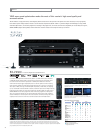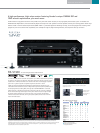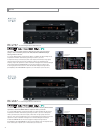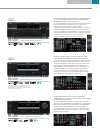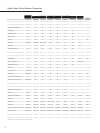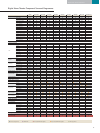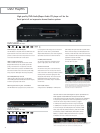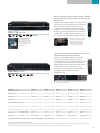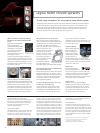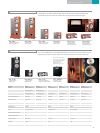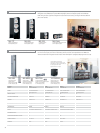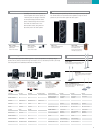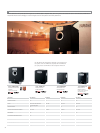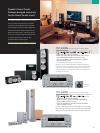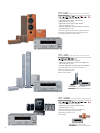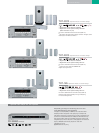
28
How Yamaha achieves our “ideal” sound.
The key to achieving the purest, most natural, and most
pleasing sound is balance. Balance among the above
three elements, balance among all the components
that make up the speaker, and balance among
subjective listening judgments.
Testing and More Testing
Yamaha tests speakers in various ways, both before and
after production. Each part of the speaker, be it a coil,
a capacitor, or a cabinet, is selected out of many
alternatives, which may be tested for months before a
decision is made. In the case of cabinets, for example,
we often build 50 to 60 cabinets and test each one. In
order to test many cabinets with many drivers in many
configurations, we begin with computer simulations, then
move to actual prototypes for measuring a myriad of
factors, such as the variations of standing waves inside the
cabinet. An anechoic chamber is used to obtain precise
acoustic data on pre-production models. Even speaker
finishes are rigorously tested for durability and how they
influence the sound. We have an environmental room
where speakers are tested for 500 hours in Amazon rain
forest conditions, and five different listening rooms,
where speakers are carefully evaluated reproducing a
variety of music and movie sources.
The Final Judgment
Throughout the design process and especially in the
final phase, our most important test equipments are the
ears of our speaker experts. Having hard data is helpful,
but deciding which cabinet sounds “better” and whether
the speaker meets Yamaha’s high standards can only be
done by the “golden ears” of Yamaha speaker designers
who have dedicated their lives to the pursuit of beautiful,
natural sound.
1. Many cabinets are built and tested for each speaker series.
2. A testing room that simulates an actual listening room.
3. A wide range of parameters are tested.
4. Speakers undergo harsh environmental testing.
PMD Cone Woofer Uses Advanced Technology
and Materials (515 PMD, 225 PMD and PMD
Series)
Digital Home Cinema Speakers
feature a unique Polymer-
injected Mica Diaphragm (PMD).
The diaphragm is composed of
30% top-quality white Indian
Pearl Mica, chosen for the
amazing contribution it makes to
sound quality. In order to
maximise its distinctive qualities, absolutely no
colouring is added to the material, and the cone's
shape, produced by injection moulding, is a natural
catenary curve. Extremely lightweight, it achieves
good stiffness along with ideal internal loss and a
high modules of elasticity.
WSD Cone Midrange and Woofer (HX Series)
Yamaha's White Spruce Diaphragm (WSD) material
emerged from an intensive search for a light, tough
diaphragm material that would help us achieve
ideal home cinema sound. The pulp material used
for the WSD is manufactured almost entirely from
long fibres of Canadian evergreen white spruce, the
world's lightest single-sheet diaphragm material.
Waveguide Horn (HX Series and EF Series)
When conventional direct radiating speakers are
used in a home environment, their broad directional
characteristics result in a relatively high proportion
of reflected sound. Modern movie theatres,
however, are designed to offer a highly absorptive
acoustic environment in which
soundtrack recordings with five or
more channels can be used to
achieve a rich sense of spatial
expression. To achieve a similar
level of spatial expression at
home, it is therefore necessary
to use speakers with a
direct/reflected sound ratio
that is quite different from
the speakers used for conventional music recordings.
All-Aluminium Dome Tweeters and Diffusers (HX
Series and 515 PMD Series)
Both the shape and material used for dome tweeter
diaphragms and diffusers were refined to improve
speed and response. 30µm pure aluminium film was
formed into a new dome shape and fitted with an
all-aluminium diffuser for wide-ranging 50kHz
sound reproduction capability.
3cm Aluminium-Magnesium Dome Tweeter with
DC-Diaphragm™ (225 PMD Series)
The high-performance tweeter features a dome
made of an aluminium–magnesium alloy, with a
DC-Diaphragm™ (integrated diaphragm and voice
coil). The tweeter is extremely light to minimise
loss yet is highly durable. It is capable of
reproduction all the way up to 50kHz, which is rare
for a 3cm dome tweeter. Highs are crisp and clear
even at high power levels.
QD-Bass Technology
QD-Bass (Quatre Dispersion
Bass) technology uses
down-firing drivers with
square, pyramid-shaped
reflective plates to radiate
the sound efficiently in
four horizontal directions. The reflective plates
negate any effects caused by the floor surface and
reduce resonance between sound waves reflected
from the floor and the unit.
Advanced YST
Advanced Yamaha Active
Servo Technology (Advanced
YST) is a unique system in which the speaker and
amplifier work together to cancel out impedance so
the speaker unit has a perfectly linear motion.
Advanced YST helps to ensure the highest levels of
sound pressure and overall performance.
Advanced YST II
In Advanced YST II, an Advanced Negative
Impedance Converter enables the speaker cone to
be driven with even tighter control. The result is
more stable and accurate low range response, as
well as higher sound pressure levels, for more
natural and energetic bass reproduction.
Microscopic View of
Polymer-Injected Mica.
1 432
Waveguide Horn (NS-8HX)
Digital Home Theatre Speakers
A wide range of speakers for every type of home theatre system
As high-quality home theatres have become more popular, Yamaha has created high-performance speakers
to match. These speakers are characterised by their robustness and dynamism in the reproduction of the
current multi-channel sound standard and offer the music lover a pleasant musical sound. Thanks to its
own patented technologies, such as Advanced YST or QD Bass, Yamaha subwoofers offer powerful and
precise bass reproduction from robust housings with compact dimensions.



